New Saws for Changing Needs
Words: Dan Kamys
Saws
Advanced technology, dust collection and portability define the next generation of masonry saws.
By Brett Martin
[caption id="attachment_10559" align="alignnone" width="416"]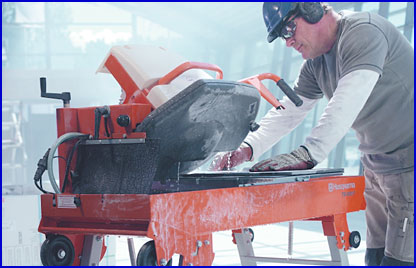 Image Courtesy of Husqvarna[/caption]
Image Courtesy of Husqvarna[/caption]
Tighter restrictions on dust control combined with a need for greater versatility and maneuverability are driving the market.
Mark Michaels, director of product management for Olathe, Kan.-based Husqvarna Construction Products North America, says his company is currently working on new saws that will be available in the second half of 2008. The saws will answer the market demand for lighter weight masonry saws that are easier to transport and easy to use, yet rugged.
"The contractor is seeing a need for better portability, although toughness and durability are still important," Michaels says. "Our development now is on good portability and good versatility. The saws need to cut a variety of material."
New technologies, better performance
STIHL Inc. has an advanced air filtration system on its new 12-inch TS 410 and 14-inch TS 420 saws that delivers 99.96 percent clean air to the machines and eliminates the need to clean the filter.
"One of the most significant advancements on the new STIHL Cutquik cut-off machines is the X2 air filtration system," says Adam Hanks, industrial product manager for STIHL in Virginia Beach, Va. "It's virtually maintenance free: When the operator notices a drop in power, they simply replace the filter. For an average user, that's usually up to one year."
[caption id="attachment_10556" align="alignright" width="250"] STIHL...14-inch TS 420 Image Courtesy of Mississippi Valley Stihl[/caption]
Hanks says a newly designed, anti-vibration system cuts vibration almost in half. A larger fuel tank offers a longer run time than previous models. New engine technology also increases fuel efficiency while cutting emissions.
STIHL...14-inch TS 420 Image Courtesy of Mississippi Valley Stihl[/caption]
Hanks says a newly designed, anti-vibration system cuts vibration almost in half. A larger fuel tank offers a longer run time than previous models. New engine technology also increases fuel efficiency while cutting emissions.
"When compared to previous models, operators will appreciate the 43 percent reduction in vibration, giving them greater comfort and reduced fatigue, as well as the improved fuel efficiency and an increased runtime of 20 percent," Hanks says. "The stratified charge technology also yields a 44 percent reduction in emissions."
[caption id="attachment_10555" align="alignleft" width="250"]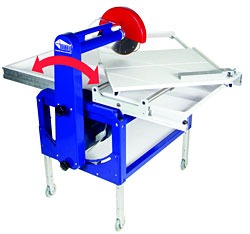 Diteq...Rocket Image Courtesy of Diteq[/caption]
Lee's Summit, Mo.-based DITEQ Diamond Tools and Equipment brought its Rocket 3600, a portable, precision saw, to market last year. The Rocket is designed to cut the larger tiles, stone slabs, marble and granite commonly used in commercial and upper scale residential jobs, says DITEQ President Dan Steiner.
Diteq...Rocket Image Courtesy of Diteq[/caption]
Lee's Summit, Mo.-based DITEQ Diamond Tools and Equipment brought its Rocket 3600, a portable, precision saw, to market last year. The Rocket is designed to cut the larger tiles, stone slabs, marble and granite commonly used in commercial and upper scale residential jobs, says DITEQ President Dan Steiner.
"There is so much larger stone being cut," Steiner says. "It's specialty stone work, but it's expensive stonework."
Capable of making extremely accurate cuts — to within five-thousandths of an inch — the saw offers a 24-inch-square cutting cart with an extension that accommodates slabs up to 24 X 36 inches. The saw handles rip cuts up to 38 inches, and it rotates up to 90 degrees for precise angle cuts.
"With the growing use of large tile and more expensive stone materials, the time for a saw like the Rocket has come," he says. "It's not for everyone, but contractors who get into these larger jobs absolutely love the combination of precision, capacity and portability the Rocket delivers."
Moving toward dust-free cutting
Manufacturers are finding ways to contain dust. MK Diamond Products Inc. in Torrance, Calif., has a new dry-cutting saw, the BX-4, that eliminates dust by using a water mist, says Brian Delahaut, company VP and general manager. The mist doesn't get the masonry materials wet.
[caption id="attachment_10560" align="alignright" width="250"]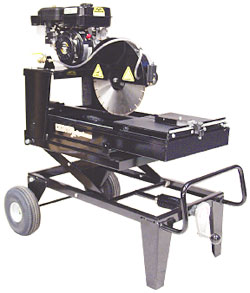 CONTRx Systems HSS-14.Silo Image Courtesy of Equipment Development Co., Inc.[/caption]
"It uses about one and one-half gallons of water over an eight-hour period and cuts down about 70 percent of dust," Delahaut says. "The mist is going to cut down on the dust and still have the benefit of cutting dry."
CONTRx Systems HSS-14.Silo Image Courtesy of Equipment Development Co., Inc.[/caption]
"It uses about one and one-half gallons of water over an eight-hour period and cuts down about 70 percent of dust," Delahaut says. "The mist is going to cut down on the dust and still have the benefit of cutting dry."
An open back and 14-inch blade let the saw cut blocks up to eight X eight X 16 inches. After a full day of cutting, there's no slurry to deal with.
"At the end of the day, the mist dries, and you just have debris in the bottom of the pan," Delahaut says. "You don't have to throw out any slurry. You basically clean out the pan, but you don't have the disposal issue. There's really no reason to have a flood system any longer."
Masonry Tec Products is now offering two vacuum systems that attach directly to dry saws to minimize exposure to silica dust, says Paul Guth, VP for the Moreno Valley, Calif., company. The JackVac 1000 and the JackVac 2000 have a dust collection drawer that contains the dust. The vacs can be hooked up to almost any manufacturer's saw.
"There's a huge movement toward 'dust free' in masonry. Masonry contractors realize that they can't just let the dust fly anymore," Guth says, noting that his dust collectors contain about 98 percent of the dust on a dry saw, depending on cutting conditions.
[caption id="attachment_10557" align="alignnone" width="416"]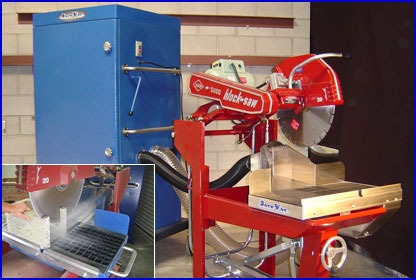 Masonry Tec JackVac 2000 Image Courtesy of Masonry Tec[/caption]
Masonry Tec JackVac 2000 Image Courtesy of Masonry Tec[/caption]
"Dust collection is a definite benefit to the workers and to the employer," he explains. "It gives them the advantages of dry cutting, and they can keep the saw close to the work area."
Guth says dry cutting eliminates a giant headache. "Water is the easiest way to deal with the dust, but the water creates other problems," he says. "We developed our dust collection system so contractors could keep the advantages of dry cutting, while using an effective means to contain the dust."
[caption id="attachment_10561" align="alignright" width="250"] Diamond Vantage ISDE Image Courtesy of Diamond Vantage[/caption]
Contractors don't want complaints about dust from their workers, their customers or the general public, so they're looking at ways to control that dust, says Husqvarna's Michaels.
Diamond Vantage ISDE Image Courtesy of Diamond Vantage[/caption]
Contractors don't want complaints about dust from their workers, their customers or the general public, so they're looking at ways to control that dust, says Husqvarna's Michaels.
"Our challenge is to make it easier for the customer," Michaels says. "We want to make a saw the customer will appreciate and like to use, and not view it as an inconvenience to meet regulations."
Masonry contractors aren't asking for a big dust collector, but if the job requires it, the demand will be there.
"Less noise and less dust are the big issues," Michaels says. "The environment and regulations also play a role. We're seeing more concern about dust. It's our responsibility to control that dust for the customer."
Portable, versatile hardscaping saws
[caption id="attachment_10558" align="alignright" width="173"]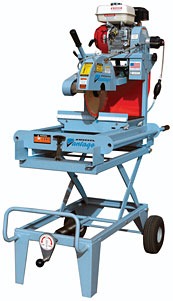 Diamond Vantage IBB-14 Image Courtesy of Diamond Vantage[/caption]
Making saws portable is increasingly important, especially for hardscaping contractors who need to move saws around the jobsite. Manufacturers are focusing on designing easily transportable saws. Diamond Vantage Inc., in Grandview, Mo., has an optional cart for moving its DVIBB 14-in. masonry saw.
Diamond Vantage IBB-14 Image Courtesy of Diamond Vantage[/caption]
Making saws portable is increasingly important, especially for hardscaping contractors who need to move saws around the jobsite. Manufacturers are focusing on designing easily transportable saws. Diamond Vantage Inc., in Grandview, Mo., has an optional cart for moving its DVIBB 14-in. masonry saw.
"The pro cart makes the saw mobile and versatile," says Graeme Gilmour, president and CEO of the company. "The height is adjustable, and you can move it around the jobsite very easily."
That saw and the 20-inch DVIGMS saw are available in gas or electric. Since the saws are made in America, masonry contractors can quickly get replacement parts.
Frederick, Md.-based Equipment Development Co. Inc. recently introduced CONTRx Systems, a new line of hardscaping saws. "There's plenty of power, and they're portable," says Chuck Hommey, marketing director for the company, adding that the gas-powered saws offer the benefit of not requiring an electrical power source. "Gas saws provide more power — a higher horsepower — and you don't need to hassle with running extension cords."
[caption id="attachment_10553" align="alignnone" width="416"] CONTRx Systems HSS-14. Image Courtesy of Equipment Development Co., Inc.[/caption]
CONTRx Systems HSS-14. Image Courtesy of Equipment Development Co., Inc.[/caption]
Hardscaping is a growing market for masonry saws, says Husqvarna's Michaels. Hardscaping contractors want a saw that's less expensive than saws used in traditional masonry, and it has to be lightweight so workers can move it around the jobsite, such as along a decorative sidewalk.
[caption id="attachment_10554" align="alignleft" width="186"]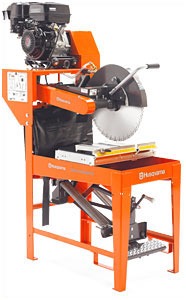 Husqvarna HC620. Image Courtesy of Husqvarna[/caption]
"Landscaping has been a fast-growing industry," Michaels says. "Landscapers want a less-expensive saw with more portability."
Husqvarna HC620. Image Courtesy of Husqvarna[/caption]
"Landscaping has been a fast-growing industry," Michaels says. "Landscapers want a less-expensive saw with more portability."
Hommey says Equipment Development's new saws, with 10-, 14-, and 20-inch blades, have a patented dust-collection system for dry cutting.
"It allows you to cut your pavers all day and not get the material wet and end up with slurry," Hommey says.
A garden hose hookup is included to provide a clean water supply, if masonry contractors want to wet cut. A fixed engine platform minimizes vibration. The masonry material is moved through the saw, instead of the other way around.
"Our blade is fixed so the engine is not moving," Hommey says. "This allows the engine to perform with optimum power. The saw lasts longer, and you get a smoother cut, less vibration and a cleaner cut, time after time."
Gilmour says Diamond Vantage saws also offer a fixed platform cutting system. "It isolates the engine from the cutting," he says. "You're not tilting the engine, which lets it perform better."
Editor's Pick:
New Rat-Tail Angle Grinders
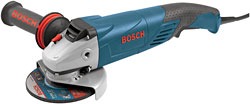 Angle grinders provide an option for cutting some brick and pavers. Last year, Mount Prospect, Ill.-based Bosch Power Tools and Accessories added two new five-inch, lightweight Rat-tail angle grinders to its lineup.
The 1821 and the 1824E weigh slightly more than 5 pounds, says Ryan Anderson, Bosch product manager. Electronic Kickback Protection in the 1824E model provides extra protection against kickbacks. Electronics monitor for a quick drop in RPMs, caused by a wheel binding in the material, and shut it off to eliminate kickback. Mechanical clutches allow the wheel to slip to further reduce kickback.
"An anti-vibration handle cuts vibration by 60 percent," Anderson says. "The handle is much easier to hold for long periods of time. You can use the tool all day without getting tired or fatigued." Angle grinders provide an option for cutting some brick and pavers. Last year, Mount Prospect, Ill.-based Bosch Power Tools and Accessories added two new five-inch, lightweight Rat-tail angle grinders to its lineup.
The 1821 and the 1824E weigh slightly more than 5 pounds, says Ryan Anderson, Bosch product manager. Electronic Kickback Protection in the 1824E model provides extra protection against kickbacks. Electronics monitor for a quick drop in RPMs, caused by a wheel binding in the material, and shut it off to eliminate kickback. Mechanical clutches allow the wheel to slip to further reduce kickback.
"An anti-vibration handle cuts vibration by 60 percent," Anderson says. "The handle is much easier to hold for long periods of time. You can use the tool all day without getting tired or fatigued." |
Brett Martin is a Minneapolis-based freelance writer with 15 years of construction and writing experience.